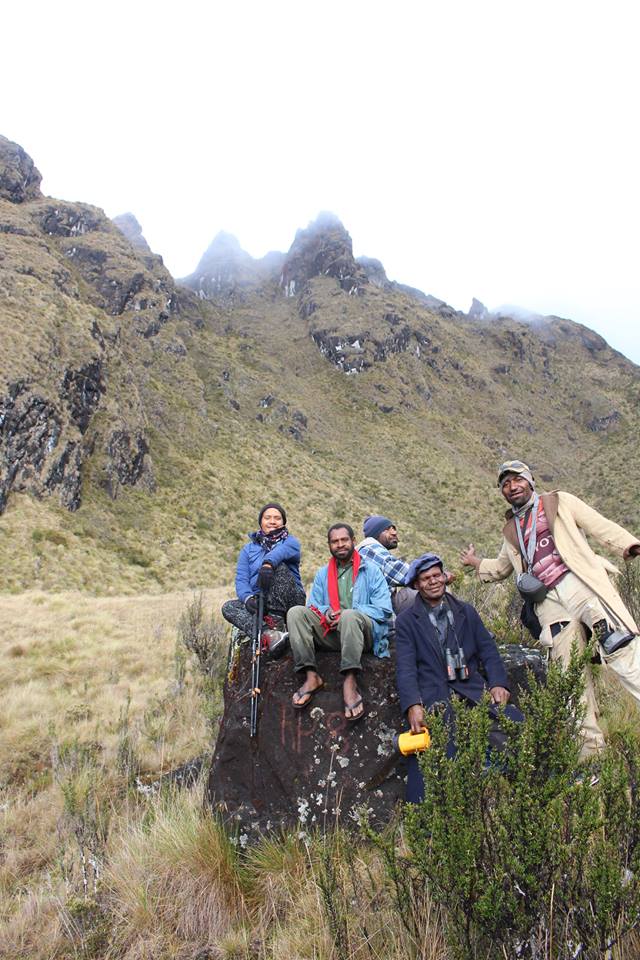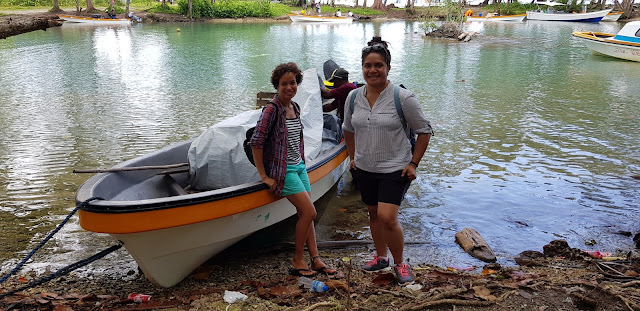Makan Nem, and a chicken sacrificed
"...she is light skinned, the spirits will harm her in Dekmba Krukl". This was the whisper that went through the community when they heard that I would be leading the expedition into a sacred part of their forest called Dekmba Krukl. I arrived from Goroka in the main village of Danbagl bright-eyed and bushy-tailed for my first fieldwork but what followed was a long evening of lectures from the village elders on tambu rules and conducts that I had to follow for my safety in the forest. Apparently being light skinned and heading out to the forest was considered dangerous as the makan nem or papa graun (spiritual guardians ) were attracted to light-skinned people or anyone that looked different.
Gembogl. The first thing that comes to mind when I hear of this place is glorious organic vegetables. The biggest broccoli, cauliflowers, carrots, potatoes, peas, garlic and of course bulb onions to name a few. Glorious food reflecting the people who plant them- big well-built with what I like to term as pasin kilim lain (people who love everyone). Gembogl is home to the highest ranges in PNG surrounded by a very jagged and difficult terrain and you'd need a good 4WD with a confident driver. Prior to road constructions now underway, driving there was not for the faint-hearted.
I was very privileged to become a part of two communities (Danbagl and Womkama) through working with the Wildlife Conservation Society PNG. My adventures here involves hiking for at least 12 hours at a time, showering twice in a week, sleeping in an underground shelter filled with smoke and I have studied (and sometimes eaten) many wildlife species with the help of some of the most gentle and hardworking men I've ever met.
So coming back to Dekmba Krukl. This was a very sacred place where only people with immediate blood ties to landowners passed through. It is believed that the makan nem or papa graun would paulim ai blo ol lain (create hallucinations) or sometimes snatch you forever. Worst case scenario, you would die after you returned from the forest. To avoid this as a visitor, you must be introduced to the forest by a landowner with the spilling of blood. In this ceremony, three chickens were killed and their blood poured onto the bare soil as they yelled out our names and told the forest that we were there to work with the wildlife and not there to cause any harm. I felt a little at ease once this was over.
Some of the rules I had to follow were very basic like not littering or bringing food that was traditionally valuable but did not grow in the forest like taro, sugar cane, ginger, salt, red pandanus (mareta). I was told not to even mention any of these food out loud in the forest because I would offend the forest. We were not allowed to speak ill of someone else or mention the names of people who have passed away. If you did, they would appear. Even the food you call out will appear. I did not want anything appearing! especially if the toilets are twenty metres away in pitch black darkness in a misty forest.
I spent about three weeks camped out with a party of about twelve people at a time. Because of the landscape and the need to be within cellphone reach, our camp was in the middle of two mountain peaks and I needed to survey birds and mammals beyond those peaks. Our schedule began at 4:30 am. Wake up, get your gear on, notebooks, water bottle and flashlights and we'd hike uphill (about 3200 masl) until 5.30 am when the birds wake up and start chirping.
Out here, I am absolutely reliant on the local hunters who recognise every single bird call. My go-to guy is called John Pisaman, a jack of all trades and I believe if he went to college, he would make a fine ecologist! We would sit in the cold, damp forest floor for five minutes and start recording all the birds that we see and hear and estimate the distance they were calling from. After five minutes, we would walk in a straight line for five minutes and record again. This would continue for an hour over about six points. Around 6:30 and7:00am we hike back to camp and have our breakfast- No.1 tea with 3-4 spoons of sugar, Wopa and Hiway Hardman biscuits heaved with a thick layer of peanut butter for the guys but I prefer ash-cooked kaukaus.
From 8am to 5pm, we search for rat, wallaby and cuscus tracks as someone goes ahead making a road for us with a sharp machete through the thicket. Once found, we set cameras, and place and disguise live traps for the rats. The live traps are checked daily to get live rats, weigh them, measure their feet, tail, ears body, photograph them and then we send them off. Our camera traps are left out for the whole three weeks. They basically detect movement and body heat given off by animals and start capturing them. I am now reviewing all the pictures and it has been a thrilling process seeing what animals get up to free from human disturbance.
On the steep slopes of the mountain, I've had to be very careful with my footholds, my weight and making sure I have a steady grip on growing tree bark or a firm hand before moving across. At the end of the fieldwork when we return to the village, there is a long line of hugs, ai wara mamas and calls of aiyahh whooo! maunten meri ya kam bek ya! and the bags of food start rolling in!
And now, I cannot wait to go back for another adventure. This time in Manus Island.
 |
| A second track to Mt Wilhelm through Womkama with my field assistants Sam, Thomas, Toppy and John. |






Enjoyed reading this..!
ReplyDeleteOur culture of "makan nem" appeasing is vital to practise as it entails the rules of conservation with an attachment to our spiritual being, despite our skin complexion.
Appreciate that you are shedding some light into the work you do for conservation in our homeland, PNG.
Thank you Ellery! I'm glad you enjoyed reading this. Our ancestors practiced conservation long before the west ever invented the term!
DeleteVery interesting read and beautiful photos too. Thanks for sharing a piece of your adventure, a sense of abundance, simplicity, serenity and wonderful people. I concur that engaging rules were tools to conserving the forest, environment and land. Look forward to your next adventure.
ReplyDeleteHi there,
DeleteThank you for leaving a comment and I am happy to know you found it interesting. Our people and the way our forefathers lived has always been in harmony with our land, forest and waters.
I love this!!!
ReplyDeleteBrings back good memories of the field..
Thank you for taking the time to read. Field days are hard but always the best times when you look back
DeleteHi Grace,
ReplyDeleteVery inspiring. Thanks for sharing. We need to work hard to preserve some of the traditional beliefs and values. Thanks for your insight to start sharing. Well done...God Bless your work.
Wow!!! Beautiful post Grace! It sure brought back old memories, when I would hike up the mountians to see my grandmother and explore the surroundings. Oh and what you said about the local guides is facts!! Yu lukim ah, ass blo dispela white stone ya ol karuka diyai stap, bhahahaha I'd be walking for another 2 hours.
ReplyDeleteI am so looking forward to read all your post. Keep em coming! <3
Fascinating work, Grace. Ild be v. interested in a bit more detail about your research aims/questions?
ReplyDeleteBy the way, re Kuman names for birds and animals (and plants): I hope you've seen the lists compiled by Joachim Sterly in his great work:
Sterly, J. 1997. Simbu Plant-lore: Plants used by the people in the Central Highlands of New Guinea, # Vols. Volume 1. The People and Their Plant-Lore,2 Volume 2. Botanical Survey of Simbu Plants. Volume 3. Ethnographical Key. Berlin, Dietrich Reimer Verlag.
Bird and mammal names (Kuman and zoological) are in Vol 2).
Also there are earlier unpublished lists by Geoff and Jeanette Hope from their work on Wilhelm in the early 1960s.
I can send you these as pdfs if yould would like them?.
Robin Hide
Hi that's amazing feedback! I would love if you could send them at nugiga2013@gmal.com and would love to continue the conversation via email. Cheers!
DeleteAre you Robin Hide as in the Robin Hide from ANU?? Wow!! This is amazing. I look forward to hearing from you
DeleteEnjoy reading it. It seems like yesterday hahaha. Proud of your achievements
ReplyDeleteJk
Delete